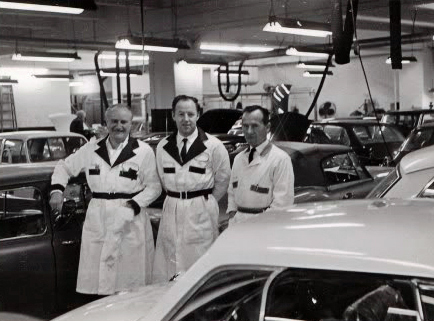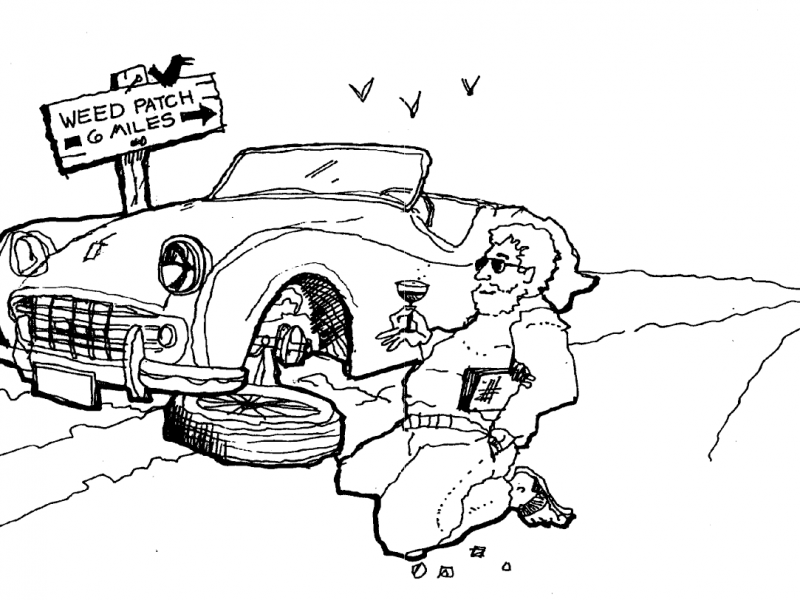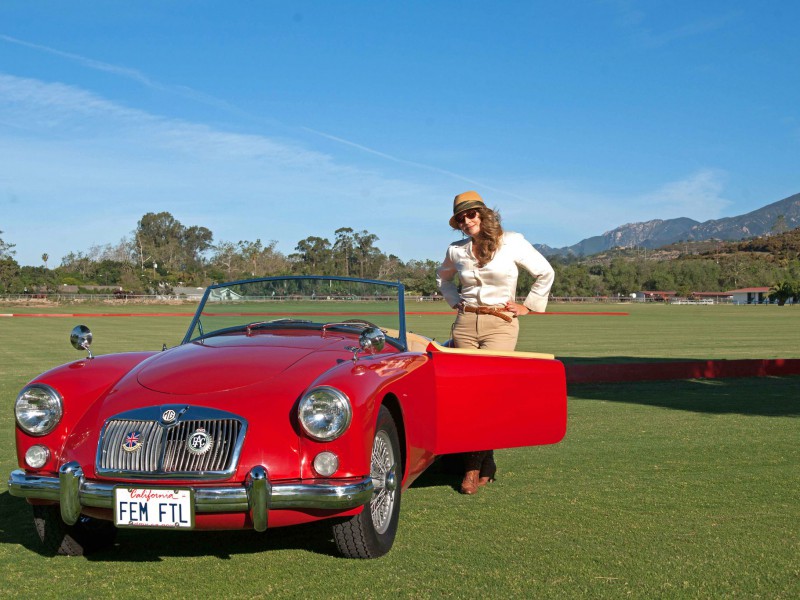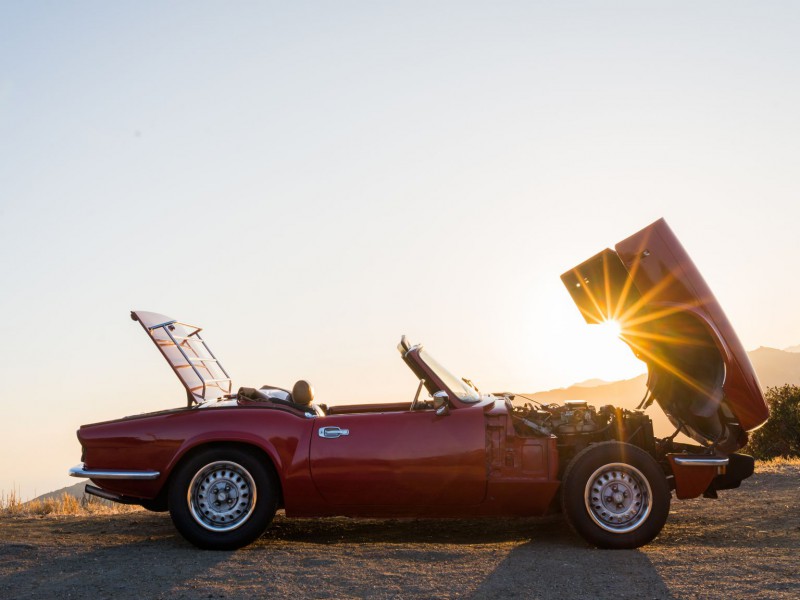Manhattan Mechanic
By Norman Tuck
I owe a debt to a handful of men, my friends and mentors from my past. I feel that it is important to offer a glimpse, however fleeting, of the lives of a diverse class of skilled workers who shared a love for British automobiles of the period, yet have never had the privilege of actually owning one. These men kept the cars running for us and should be acknowledged.
I left Florida for New York. It was September of 1967 and I was 22. I fit my tools and my clothes into a polished green MGB and followed Interstate 95 North to the Holland Tunnel toward a new life.
In the Yellow Pages I found Adams-Mahoney & Company, an authorized MG repair shop at 429 East 74th Street on Manhattan’s Upper East Side. I was told to bring my toolbox on Monday to start work.
That night I parked the MG in front of Emmanuel Turk’s real estate office on East 14th Street. I slept as best I could in a bucket seat, hidden from the street beneath the roadster’s black tonneau cover. In the morning I was the first in line to meet Mr. Turk. He was an older Hasidic Jew who had been filling the Lower East Side with a new breed of kids like me. I was, suddenly, a New Yorker.
The Workplace
Weekdays began with an exhilarating 74-block run up First Avenue. Synchronized traffic lights, top down, and fast. I should have punched in by 8:00am, but I was always late. One day my boss offered to raise me to $100 a week if I showed up on time. My promptness improved considerably.
The garage would be nearly empty on Monday mornings, with just a few dust covered older exotics waiting for parts. Then the cars rolled in. Mostly MGBs, with a smattering of Healeys, Sprites and Minis. The little sports cars were simple, elegant machines that had never made the transition to modernity. Still, they glowed with a beauty that illuminated the darkness of the dingy shop.
A-M reflected the early days of automotive history. There were neither hydraulic lifts nor pneumatic tools. The two-story garage with its curved ramp had probably been converted from a Manhattan stable or carriage house.
In the summer the shop was unbearably hot. We were issued light, cotton uniforms. Salt tablets were available at the water fountain. Big electric pedestal fans blew hot air in from the street, but nothing helped as idling engines filled the air with hot exhaust.
It was the New York City winters that I most remember. The shop was largely unheated. Our elegant black and gold woolen winter uniforms looked terrific, but they couldn’t keep away the cold. I exhaled a foggy breath as my naked fingers did their work on cold, hard metal.
George Adams and Larry Mahoney were my bosses. They had worked side by side as mechanics at J.S. Inskip Motors, an historic importer of exotic automobiles. Inskip had provided custom Rolls-Royces and Bentleys to Manhattan’s moneyed elite since the 1930s. When Inskip dissolved in 1967, George and Larry joined to form Adams-Mahoney & Co. I suspect that they had received financing from the serious men in long, black woolen coats that occasionally arrived in big Cadillacs for long meetings in the back office.

George Adams
George Adams had organizational skills, a clear mind, and a vast knowledge of automobiles. He was a good boss who was always honest and straightforward with me and the other workers. He kept the books and steered Adams-Mahoney on an orderly path. George had been a front line soldier in World War II, and he brought a post-war American optimism with him into our work place.
On weekends George and his teenage son raced powerful American dragsters on strips in New Jersey. He had little respect for the British two-seaters that were our bread and butter.
Larry Mahoney
Customer relations was Larry’s domain. He was a charismatic entertainer whose cheerful banter with both employees and clients made the office a fun place to be.
No customer escaped Larry’s Irish charm, but he was especially attentive to the ladies. I wouldn’t want Larry to fix my car, but I always enjoyed watching him do what he did best. I grew to like the warm smell of Larry’s whisky breath as he kept up a constant chatter of good cheer. As the day wore on he would become ever more ebullient with each drink, until, at days end, he would choose the classiest customer car to take home for an extended “test drive.”

Wheels and Tires
The balancing machine had a powerful electric motor that rubbed against a front tire to spin it at high speed. First, I’d mark the wheel with a piece of chalk and then carefully place a sensor on the car’s suspension. The sensor triggered a strobe light aimed at the rapidly spinning wheel. The strobe light magically made the wheel appear still, with the heaviest area at the bottom. I would make a mental note of the wheel’s position and then stop the whirling wheel to hammer lead weights onto the rim. The process would be repeated until the wheel spun smoothly, without vibration. It required two mechanics to balance the rear, driving wheels, one to work on the wheel and the other to sit in the driver’s seat of the raised car and rev the engine with the car in high gear.
I was thrilled, and a little scared, to be working just inches away from a heavy wire wheel spinning at highway speeds. As a teenager in Miami I had watched this process being done on my father’s car, and I think it was then that I decided that, more than anything else, I wanted to work in a sports car shop.
The Mechanics
We mechanics were a mixed bag. Marcelle, Emilio and Mike were three older Europeans who had worked together at J.S. Inskip before moving on to Adams-Mahoney. Roy, Zion and Leroy were three young black men from Jamaica. Then there was me, a young man from Florida, taking it all in.
Marcelle
Marcelle was from Belgium. He was a religious man who attended Catholic Mass each morning before coming to work. I never came to work early enough to see him arrive, or stayed late enough to see him leave. He was probably in his late 50s, but his experience as a Nazi Prisoner-of-War had affected his health, making him seem older than his years. Miraculously, he found the love of his life while at A-M. His loving wife, Maria, was his glorious reward for having lived a virtuous life here on Earth. Marcell was a good person and, as our best mechanic, he was given the most difficult, technical jobs. I grew to love him and I miss him now as I sit here, writing this.
A Healey Exhaust
Sometimes it would be my job to replace the exhaust system of a big Austin Healey. I would crawl under the car with a flaming acetylene torch to remove the rusty pieces and then weld together a new assembly of heavy steel pipes, silencers, resonators and rubber hangers. It was a big job made harder when the tip of my torch got too close to a pipe and exploded with a loud “pop,” shooting sparks at my goggled face.
Mike
Mike was a heavy-set Irishman who reminded everyone of Jackie Gleason, whom he would frequently impersonate. He was our shop foreman, parts man, and third in command. Part of his job was to drive the little red and white Morris panel truck to the parts depot in New Jersey, and return to refill the shelves with needed supplies. He also worked on the major, extended mechanical rebuilds that were always lingering in the corners of the shop.
I never really liked Mike. He was untruthful about the most mundane things, making work difficult for those of us who depended upon him. He seemed to have his own agenda that I never understood. Although we seemingly got along, he was someone that I could have easily done without.

A Test Drive
In good weather I might decide that a Big Healey or Mini Cooper S needed a test drive. I drove quickly through heavy traffic to enter the FDR Drive at 79th Street and speed south, ever faster, to the exit at 63rd Street. It was a short but exhilarating circuit that would raise my spirits.
Emilio
I always felt sorry for Emilio. He had been a foot soldier in the Italian Army and, like Marcelle, World War II had not been good to him. Even though he was very experienced, having worked many years with the others at Inskip, he would often make mistakes and could no longer be trusted with difficult jobs.
Emilio could display a violent temper, and the Jamaican mechanics would taunt him just to see what he would do. I can’t forget the time he threw a heavy iron shock absorber at one of them, missing the mark but leaving a lasting gash on the concrete wall.
Mamile, as Marcelle called Emilio, was really too unhealthy to be working under our harsh conditions, and this added to his general unhappiness. He was what I call “played out.” High blood pressure made him dizzy, and his utterance, “Head no good today,” has stayed with me, especially now that I have been made intimately familiar with the manifestation.
Coffee Time
At the shop I was considered “the kid,” and it was my job to gather snacks at 10:00 and 3:00. I collected money and wrote orders on little pieces of scrap paper.
The coffee choices were: light and sweet, dark, dark no sugar, or, of course, regular (milk and sugar). Most ordered either a “butter roll” or an “egg on a roll.” The butter roll was a seeded hard roll with a big glob of glorious sweet butter hidden deep within.
I’d walk the few blocks to the Deli and stand in line with the other young gophers. I’d call my order to the counter man and then move along to pay the nice lady at the register. Like the food, the constant banter of the Deli was warm and indigenous to New York at the time. “One Regular,” was coffee without pretense.
I liked taking the orders. I liked the little walk. I liked the warmth of the Deli. But most of all I liked the 15 minutes when I joined the others to sit together and exchange stories and opinions before returning to the isolation of the work.
Roy
Roy was the oldest of the three Jamaicans. He was a family man who had come to New York to better his situation. He kept a low profile, working hard without complaint. He sent most of his paycheck back to his wife and children on “The Island.”
Every evening, after work, Roy attended night school to study computer science. His reasons for coming to New York were clear: it offered a “Land of Opportunity” where he could earn good money and receive an education that insured a bright future for him and his family after his return home.
Leroy and Zion
Leroy and Zion were a pair of young guys on the make in the Big City. At lunchtime I would attentively listen to their stories of weekend parties and the girls that they had come to know.
There was much about life in New York that was difficult. As we sat together, eating lunches in a cold repair shop, and watching falling snow through dirty, frosty windows, Leroy and Zion would reminisce about the tropical world they had left behind. I wondered what kept them in The City. With my limited, privileged background I was unable to accept that it was only money that motivated them to leave Jamaica and endure New York. I wondered if, like me, there was something more elusive that was keeping them here at Adams-Mahoney.
Epilogue
Eventually, the long days at Adams-Mahoney were no longer fun. I felt like the Sorcerer’s Apprentice: as I fixed one car, two others were breaking down somewhere else, and it was all too much for me. I never had it in me to become a real professional. I’d had enough.
I was 25 when I left New York for graduate school in Pennsylvania. It was September of 1970. I fit my tools and my clothes into a ragged MGB and headed west over the George Washington Bridge to follow Interstate 80 toward a different life. MM









'Manhattan Mechanic' have 3 comments
November 30, 2018 @ 11:53 am John Wright
Norman, thank you very much for this account of your time at Adams-Mahoney. As you know, the old parts runner Van is alive and on the mend. I am serious about restoring this historic Morris and happy to say that the Van Cab is back from the blaster and ready to start rust repair. Chassis is done and in chassis black. Its a big project in spite of it’s small size. It gave it’s all in NYC and thankfully it can be rebuilt! 11/30/2018
April 3, 2019 @ 7:01 am Ed Lind
I pickup the very first new car purchase of my life at A & H . My car was a 1970 Royal Blue MGB that was purchased earlier in June in London. A & H did a good job for me. It was a fun trip home to Erie, PA.
January 23, 2024 @ 6:23 am Jagrit
Wow what an article, literally hats off to people who help us with our car, I’m also very thankful to the best mechanics in New York City. who handle my car, they are my mom’s friends.